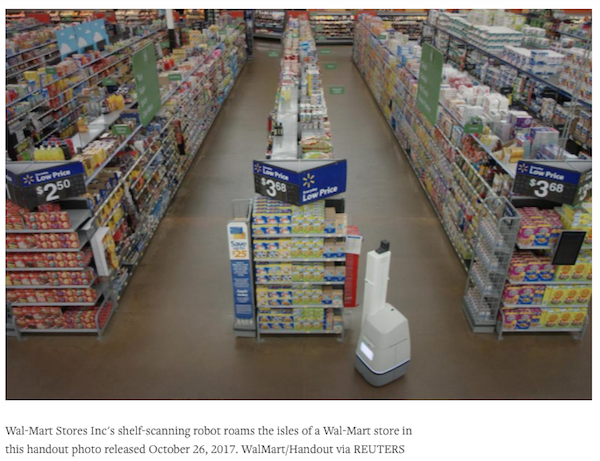
Automation Advances Further into Inventory Jobs
10/30/2017
Robots are good at counting and recording, so they are increasingly being used in stores and warehouses to keep track of the stock on hand.
As part of Wal-mart’s competition with Amazon, the store chain is utilizing Amazon’s technology strategy by moving forward with automation to up its e-commerce game.
Naturally, the efficiency and cost-savings are emphasized, rather than the inevitable job loss.
Wal-Mart’s new robots scan shelves to restock items faster, Reuters, October 26, 2017CHICAGO (Reuters) — Wal-Mart Stores Inc is rolling out shelf-scanning robots in more than 50 U.S. stores to replenish inventory faster and save employees time when products run out.

… “If you are running up and down the aisle and you want to decide if we are out of Cheerios or not, a human doesn’t do that job very well, and they don’t like it,” Jeremy King, chief technology officer for Walmart U.S. and e-commerce, told Reuters.
The company said the robots would not replace workers or affect employee headcount in stores.
The robots are 50 percent more productive than their human counterparts and can scan shelves significantly more accurately and three times faster, King said. Store employees only have time to scan shelves about twice a week.
The idea of installing robots to automate retail is not new. Rival Amazon.com Inc uses small Kiva robots in its warehouses to handle picking and packing, saving almost 20 percent in operating expenses …
Even more futuristic are the drone robots that fly around warehouses to do inventory, as the BBC recently reported:
The flying drones that can scan packages night and day, October 27, 2017Flying drones and robots now patrol distribution warehouses — they’ve become workhorses of the e-commerce era online that retailers can’t do without. It is driving down costs but it is also putting people out of work: what price progress? …
What price progress indeed? A viable economy requires shoppers as well as products, but nobody in government seems concerned about the shrinkage of the demand side of the equation. Wouldn’t preparing for the automated future make more sense than pretending it isn’t coming?
Certainly America shouldn’t import more immigrant workers, since they won’t be needed. The remaining jobs should go to Americans, period, because:
Automation makes immigration obsolete.
Need convincing? Experts paint a grim picture:
Oxford researchers forecast in 2013 that nearly half of American jobs were vulnerable to machine or software replacement within 20 years. Rice University computer scientist Moshe Vardi believes that in 30 years humans will become largely obsolete, and world joblessness will reach 50 percent. The Gartner tech advising company believes that one-third of jobs will be done by machines by 2025. The consultancy firm PwC published a report earlier this year that forecast robots could take 38 percent of US jobs by 2030.
